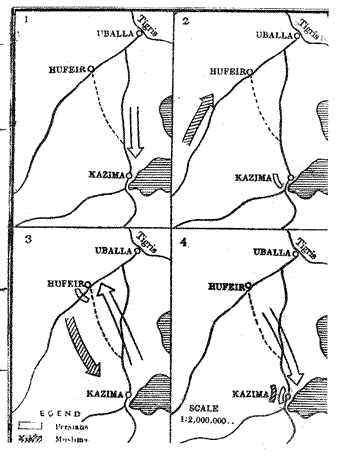|
Having written to Hormuz
from Yamamah, Khalid knew that the Persian would expect him to advance
on the direct route from Yamamah to Uballa, via Kazima, and would
make his defensive plans accordingly. Khalid decided not to move
on that route, but to approach Uballa from the south-west so that
he would be free to manoeuvre on two axes-the Kazima axis and the
Hufair axis-thus creating a difficult problem for the less mobile
Persians. With this design in mind he marched to, Nibbaj, dividing
his army into three groups as already explained, and took under
command the 2,000 warriors of Muthanna, who, along with their intrepid
chief, were awaiting Khalid at Nibbaj. 1
From Nibbaj he marched in the direction of Hufair, picking up the
other three chiefs on the way, and approached Hufair with 18,000
men.
Khalid was not in the least worried about
the presence of the Persian Army at Kazima. Hormuz at Kazima posed
no threat to Khalid, for the Persians could not venture into the
desert to disrupt his communications, apart from the fact that a
mobile force like Khalid's operating in the desert did not present
particularly vulnerable lines of communication. Khalid made no attempt
to rush through Hufair and make for Uballa, because with Hormuz's
large army on his flank his forward movement beyond Hufair might
spell serious trouble. Hormuz could fall upon his rear and cut his
line of retreat. No Arab would ever accept interference, or even
a threat of interference, with his route back into the friendly,
safe desert where he alone was master. Hence Khalid waited in front
of Hufair, while light detachments of his cavalry kept Hormuz under
observation. He knew, that his presence near Hufair would cause
near-panic in the mind of Hormuz.
This is just what happened. The moment Hormuz
got word of Khalid's movement towards Hufair, he realised the grave
danger in which his army was placed. The Arab was not so simple
after all! As an experienced strategist, he knew that his base was
threatened. He immediately ordered a move to Hufair, 50 miles away,
and his army, weighed down with its heavy equipment, trudged along
the track. The two days' march was tiring, but the tough and disciplined
Persian soldier accepted his trials without complaint. On arrival
at Hufair, however, Hormuz found no trace of Khalid. Expecting the
Muslims to arrive soon, he deployed for battle as he had done at
Kazima, chains and all; but hardly had his men taken up their positions
when his scouts came rushing to inform him that Khalid was moving
towards Kazima!
And Khalid was indeed moving towards Kazima.
He had waited near, Hufair until he heard of the hurried approach
of Hormuz. Then he had withdrawn a short distance and begun a counter-march
through the desert towards Kazima, not going too far into the desert
so as not to become invisible to Persian scouts. Khalid was in no
hurry. His men were well mounted, and he took his time. He had no
desire to get to Kazima first and occupy it, for then he would have
to position himself for battle and his opponent would be free to
manoeuvre. Khalid preferred to let the Persians position themselves
while he himself remained free to approach and attack as he liked,
with the desert behind him.
The Persians again packed their bags and
set off for Kazima, for Hormuz could not leave the Kazima route
to the Muslims. Hormuz could have fought a defensive battle closer
to Uballa; but having experienced the terrible havoc wrought by
Muthanna in his district, he was in no mood to let Khalid approach
close enough to let his raiders loose in the fertile region of Uballa.
He was determined to fight and destroy Khalid at a safe distance
from the district which it was his duty to protect, and he rejoiced
at the prospect of a set-piece battle against the desert Arabs.
Moreover, armies act as magnets: they attract each other. Sometimes
an area which is not otherwise strategically important becomes so
through the presence of a hostile army. Now Hormuz was drawn to
Kazima not only by the strategical importance of the place but also
by the army of Khalid.
This time the forced march did not go down
so well with the Persians and there was grumbling, especially amongst
the Arab auxiliaries serving under Hormuz, who cursed the Persian
for all the trouble that he was causing them. The Persians arrived
at Kazima in a state of exhaustion. Hormuz, the professional regular
soldier, wasted no time and at once deployed the army for battle
in the normal formation of a centre and wings. The generals commanding
his wings were Qubaz and Anushjan. The men again linked themselves
with chains. (For a graphic illustration of march and counter-march
see Map 12 below.)

1. The old Nibbaj is the present Nabqiyya,
25 miles north-east of Buraida. (See Maps 7 and 8)
|
